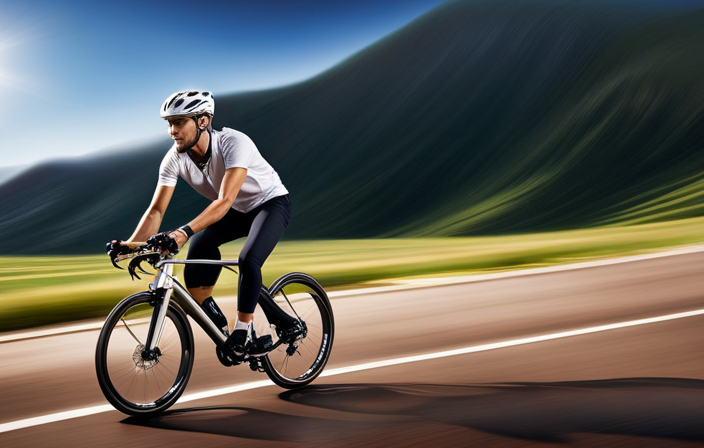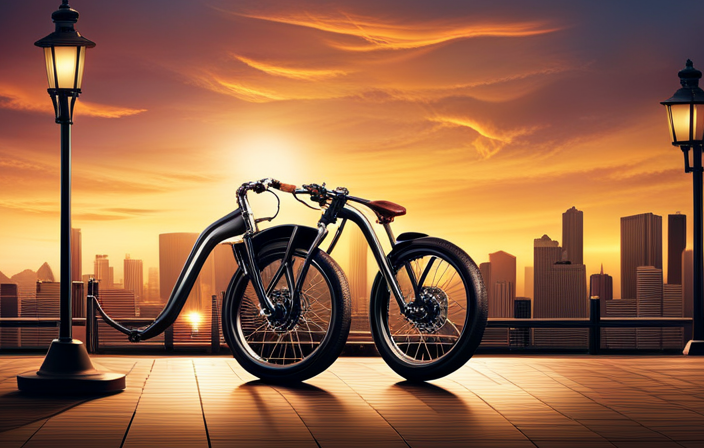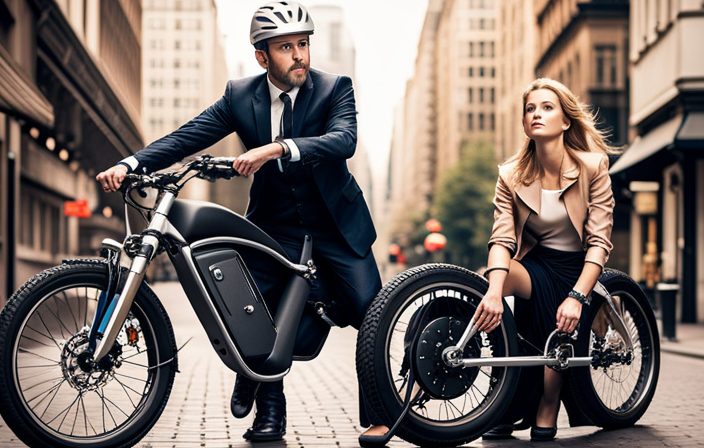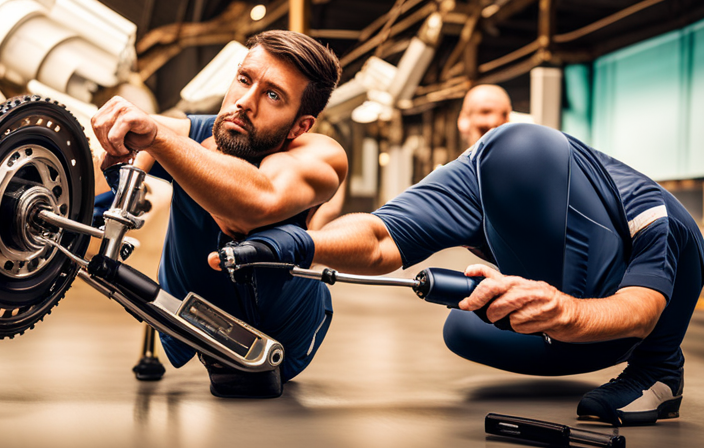Are you ready to conquer any terrain on your electric bike? The key lies in mastering the art of using electric bike gears.
By understanding gear ratios, familiarizing yourself with your bike’s gear system, and knowing when and how to shift gears, you can ensure a smooth and efficient ride every time.
In this article, I will guide you through the ins and outs of using electric bike gears, from troubleshooting common issues to exploring advanced techniques for optimal gear optimization.
Get ready to take your electric bike riding to the next level!
Key Takeaways
- Cadence and gear selection are important for maximizing power output and minimizing fatigue.
- Listening to the motor sound can help determine the appropriate gear changes.
- Adjusting gears for comfort and performance involves checking alignment, finding the ideal gear range, and maintaining the gears.
- Regular maintenance and cleaning of the gear system is crucial for longevity and smooth shifting.
Understanding Gear Ratios
Understanding gear ratios is crucial when learning how to use electric bike gears. Gear ratios determine the relationship between the number of teeth on the front chainring and the rear cog. This ratio affects how much power is transferred to the wheels and ultimately determines the bike’s speed and performance.
Proper gear maintenance is important to ensure smooth shifting and prevent premature wear. Regularly cleaning and lubricating the gears will help maintain their efficiency.
When it comes to gear selection techniques, it’s essential to anticipate changes in terrain and adjust accordingly. Start in a lower gear when climbing hills and shift to a higher gear on flat or downhill sections to maximize speed.
By understanding gear ratios and practicing proper gear maintenance, you’ll be well-equipped to get familiar with your electric bike’s gear system and optimize your riding experience.
Getting Familiar with Your Electric Bike’s Gear System
Familiarizing yourself with the gear system on an e-bike is essential for a smooth and enjoyable ride. Understanding gear mechanisms and the benefits of using electric bike gears will help you make the most of your e-bike experience.
Here are four key points to keep in mind:
-
Gear Range: Electric bikes usually come with a wide range of gears, allowing you to adjust the resistance and find the right level of assistance for different terrains.
-
Gear Shifting: Familiarize yourself with the gear shifter and understand how it works. Start by using lower gears for uphill climbs and higher gears for flat or downhill stretches.
-
Power Management: Using the gears efficiently will help you optimize battery usage. Lower gears provide more assistance, while higher gears conserve battery power for longer rides.
-
Speed and Cadence: Experiment with different gear combinations to find the optimal speed and cadence for your riding style and comfort.
By understanding these gear mechanisms and their benefits, you’ll be better equipped to know when to shift gears and optimize your e-bike’s performance.
Knowing When to Shift Gears
Knowing when to shift gears is crucial for a smooth and efficient ride on your e-bike. To ensure a seamless transition between gears, it is important to understand the optimal gear selection techniques. This can be made easier by paying attention to the cadence, or the speed at which you pedal. A higher cadence usually calls for a lower gear, while a slower cadence requires a higher gear. Additionally, consider the terrain you are riding on. When going uphill, shifting to a lower gear will provide the necessary power and torque. On the other hand, when riding downhill or on flat surfaces, shifting to a higher gear will allow you to maintain a steady speed without exerting excessive effort. By mastering these gear selection techniques, you can achieve smooth transitions and enhance your overall riding experience. In the next section, we will delve into shifting techniques for smooth transitions without compromising speed or performance.
Shifting Techniques for Smooth Transitions
To achieve smooth transitions on your e-bike, you’ll need to master the art of shifting gears efficiently. Proper gear shifting techniques are essential for a seamless and comfortable ride.
When shifting gears, it is important to anticipate changes in terrain and adjust accordingly. Start by maintaining a steady pedaling cadence and reduce the pressure on the pedals. This will allow the gears to shift smoothly without putting strain on the drivetrain.
As you shift gears, use the gear selection strategies that best suit your riding style and the current terrain. For instance, when approaching an incline, shift to a lower gear to maintain a comfortable pedaling cadence. On the other hand, when descending or riding on flat terrain, shift to a higher gear to maximize your speed and efficiency.
Mastering gear changes on different terrains is crucial for a well-rounded cycling experience. It allows you to adapt to various riding conditions effortlessly and enhances your overall performance.
Now, let’s delve into the next section and explore how to master gear changes on different terrains.
Mastering Gear Changes on Different Terrains
When riding on various terrains, it is important to focus on mastering gear changes. This will ensure a smooth and efficient cycling experience. Proper gear shifting techniques and gear selection tips are crucial for maintaining momentum and control. Here are some key points to consider:
-
Anticipate the terrain: Before encountering a hill or rough terrain, shift to a lower gear. This will help you prepare for the increased resistance.
-
Use higher gears for flat terrain: When cycling on flat surfaces, using higher gears allows you to maintain a faster pace and increase your speed.
-
Downshift before stopping: To avoid straining your bike’s drivetrain, downshift to a lower gear before coming to a complete stop.
-
Experiment with different gears: Practice shifting between gears on different terrains. This will help you understand the optimal gear ratios for various situations.
Mastering gear changes on different terrains will greatly enhance your overall cycling performance. This knowledge will be especially useful when using lower gears for climbing uphill in the subsequent section.
Using Lower Gears for Climbing Uphill
As I tackle uphill climbs, I rely on lower gears for greater ease and control. When it comes to gear selection, it’s crucial to choose a lower gear ratio to effectively conquer steep inclines. Lower gears provide more torque, allowing me to pedal with less effort and maintain a steady pace. This gear selection also prevents strain on the motor and battery, extending their lifespan.
To ensure optimal gear performance, regular gear maintenance is essential. I regularly clean and lubricate the gears, checking for any signs of wear or damage. Additionally, I make sure the gear cables are properly adjusted for smooth shifting.
By using lower gears and maintaining them properly, I can confidently conquer uphill climbs.
Now, let’s explore how to utilize higher gears for descending and flat terrain.
Utilizing Higher Gears for Descending and Flat Terrain
For descending and flat terrain, you’ll want to consider shifting into higher gears for increased speed and efficiency. Utilizing higher gears allows you to maintain a fast pace without putting excessive strain on the motor or your legs. Here are some key downhill techniques and gear selection tips for speed:
-
Increase your gear ratio: Shifting into higher gears will allow you to pedal at a faster cadence while maintaining a consistent speed. This can help you maximize your efficiency and cover more ground with each pedal stroke.
-
Use the motor sparingly: On downhill sections, rely more on the momentum you’ve gained rather than solely relying on the motor. This will conserve battery power and make your ride more enjoyable.
-
Monitor your speed: While it’s tempting to let gravity take control, always keep an eye on your speed and adjust your gears accordingly to maintain stability and control.
Transitioning into the next section about finding the optimal cadence for efficient riding, it’s important to strike a balance between gear selection and pedaling technique to enhance your overall riding experience.
Finding the Optimal Cadence for Efficient Riding
To achieve efficient riding, it’s important to find the optimal cadence. The optimal cadence refers to the ideal speed at which you pedal to maximize your power output while minimizing fatigue. It is directly related to your gear selection.
When riding your electric bike, selecting the right gear is crucial for improving pedaling efficiency. In general, a higher cadence in a lower gear is more efficient for climbing hills, while a lower cadence in a higher gear is better for descending or riding on flat terrain. Experimenting with different gear combinations will help you find the optimal cadence that suits your riding style and terrain.
By finding the right cadence, you can pedal smoothly and maintain a steady speed. This will allow you to conserve energy and ride longer distances without excessive fatigue. Listening to your electric bike’s motor for gear changes can further enhance your riding experience.
Listening to Your Electric Bike’s Motor for Gear Changes
When listening to your e-bike’s motor, you can easily adjust your gear changes for a smoother riding experience. Motor sound analysis is a useful technique to determine the optimal time to shift gears. By paying attention to the motor’s sound, you can gauge whether it is working too hard or not working hard enough. When the motor sounds strained, it indicates that you should shift to a lower gear to reduce the load on the motor. On the other hand, if the motor sounds too quiet or is not providing enough assistance, shifting to a higher gear can maximize efficiency. To help you understand the relationship between motor sound and gear changes, refer to the table below:
| Motor Sound | Gear Change | Riding Experience |
|---|---|---|
| Loud and strained | Shift to a lower gear | Smoother and easier ride |
| Quiet or weak | Shift to a higher gear | Enhanced efficiency and speed |
By adjusting your gears based on the motor sound analysis, you can optimize your riding experience. Now, let’s explore how to adjust your gears for comfort and performance.
Adjusting Your Gears for Comfort and Performance
Optimize your riding experience by adjusting the gears on your e-bike for maximum comfort and performance. Proper gear maintenance and selection are crucial in ensuring a smooth and efficient ride.
Here are some key tips to help you get the most out of your electric bike’s gear system:
-
Check your gear alignment: Ensure that your gears are properly aligned by visually inspecting them and making any necessary adjustments. Misalignment can cause shifting issues and reduce overall performance.
-
Find your ideal gear range: Experiment with different gear combinations to find the range that suits your riding style and terrain. This will help you maintain a comfortable cadence and optimize your power output.
-
Regularly clean and lubricate your gears: Keep your gear system clean by removing any dirt or debris, and apply a suitable lubricant to ensure smooth shifting.
By following these gear maintenance and selection tips, you can enhance your riding experience.
Transitioning to the next section, let’s now discuss maintaining and cleaning your electric bike’s gear system to ensure its longevity and efficiency.
Maintaining and Cleaning Your Electric Bike’s Gear System
Make sure you regularly clean and maintain your e-bike’s gear system to ensure its longevity and efficiency. Cleaning techniques for electric bike gears may vary depending on the type of system you have.
For external gear systems, start by wiping down the gears with a clean cloth to remove any dirt or debris. Then, apply a degreaser to a brush and scrub the gears, making sure to get into all the nooks and crannies. Rinse off the degreaser with water and dry the gears thoroughly.
For internal gear systems, you may need to consult the manufacturer’s instructions for specific cleaning methods.
Common gear problems to look out for include skipping gears, noisy shifting, or difficulty shifting. These issues can often be resolved by adjusting the derailleur or replacing worn-out parts.
Troubleshooting common gear issues will ensure a smooth and efficient ride.
Troubleshooting Common Gear Issues
If you’re experiencing skipping gears, noisy shifting, or difficulty shifting, you can often resolve these common gear issues by adjusting the derailleur or replacing worn-out parts. Troubleshooting gear shifting problems involves first inspecting the derailleur hanger alignment, as misalignment can cause shifting issues. If the hanger is bent, it should be straightened or replaced.
Next, check the gear cable tension and make adjustments as necessary. A loose or tight cable can prevent smooth shifting. Additionally, examine the gear limit screws to ensure they are properly adjusted, allowing the derailleur to shift smoothly between gears.
Finally, if the gear cassette or chain are worn out, they may need to be replaced. By troubleshooting these common gear problems, you can ensure a smoother and more efficient ride.
In the next section, I’ll provide tips for extending the lifespan of your electric bike’s gears.
Tips for Extending the Lifespan of Your Electric Bike’s Gears
As we have discussed common gear issues and their troubleshooting, it is crucial to also focus on extending the lifespan of your electric bike’s gears. Proper gear maintenance techniques are essential for ensuring smooth and efficient performance.
Firstly, regularly clean your gears to prevent the accumulation of dirt and debris, which can cause unnecessary wear and tear. Additionally, lubricate the gears with a suitable bike lubricant to minimize friction and increase their lifespan.
It is also important to regularly inspect the gears for any signs of damage or wear, such as bent teeth or excessive wear on the chainring. By promptly addressing any issues and regularly maintaining your electric bike’s gears, you can significantly extend their lifespan and maximize their performance.
Now, let’s move on to the next section about practicing and building confidence in gear shifting.
Practicing and Building Confidence in Gear Shifting
To improve your gear shifting skills, start by practicing in a safe and open area to build confidence. Building strength is crucial for improving gear shifting speed on an electric bike. One effective way to build strength is to incorporate interval training into your practice routine. This involves shifting gears rapidly between intervals of high and low resistance. By doing so, you engage different muscle groups and develop the strength needed for quick gear changes. Additionally, practicing on different terrains such as hills and flat surfaces will help you become comfortable with shifting gears under various conditions. Remember to focus on maintaining a smooth pedal stroke while shifting to avoid any jerky movements or potential damage to the gears. With consistent practice and building strength, you’ll soon become proficient in gear shifting. Transitioning into the next section, exploring advanced techniques and strategies for gear optimization, allows for a deeper understanding of maximizing performance.
Exploring Advanced Techniques and Strategies for Gear Optimization
Once you have built confidence in gear shifting, it’s time to delve into advanced techniques and strategies for optimizing your gear selection.
Gear maintenance plays a crucial role in ensuring the smooth functioning of your electric bike gears. Regularly cleaning and lubricating the gears will help prevent wear and tear, prolonging their lifespan. Additionally, inspecting the gear cables for any signs of fraying or damage is important, as this can affect the shifting performance.
To maximize gear optimization, it’s essential to understand the different gear ratios and how they relate to your pedaling cadence. Experimenting with different gear combinations will allow you to find the most efficient setup for various terrains and riding conditions.
It’s also worth noting that proper body positioning and weight distribution can greatly impact gear efficiency. By positioning yourself correctly on the bike and distributing your weight effectively, you can optimize power transfer and minimize energy wastage.
Remember, practicing these gear optimization techniques will enhance your overall riding experience and make your electric bike more enjoyable to ride.
Frequently Asked Questions
Can I use the same gear ratios on my electric bike as I would on a regular bike?
No, you cannot use the same gear ratios on an electric bike as you would on a regular bike. Electric bike gear maintenance is important for optimal performance and the advantages of using electric bike gears include improved efficiency and a smoother ride.
How can I tell if I need to adjust or replace my electric bike’s gears?
To determine if I need to adjust or replace my electric bike’s gears, I would first check for any signs of wear or damage, such as skipping or grinding. If necessary, I would consult the manufacturer’s guidelines or seek professional assistance for adjusting or replacing the gears.
Are there any specific techniques for shifting gears on hilly terrains?
When faced with hilly terrains, I rely on specific shifting techniques and gear selection strategies to conquer the challenge. By anticipating the incline, I smoothly shift to a lower gear, maintaining a steady cadence and maximizing power.
What should I do if my electric bike’s gears are not shifting smoothly?
If my electric bike’s gears are not shifting smoothly, I would troubleshoot gear issues. Common gear problems include misalignment, cable tension issues, or worn-out components. Adjusting cable tension, realigning gears, or replacing worn components can usually resolve the issue.
Are there any tips for preventing wear and tear on my electric bike’s gears?
To prevent wear and tear on my electric bike’s gears, I recommend regular electric bike gear maintenance. This includes cleaning and lubricating the gears, checking for loose or damaged parts, and addressing common gear problems like skipping or grinding.
Conclusion
In conclusion, mastering the use of electric bike gears is essential for a smooth and enjoyable ride.
By understanding gear ratios and getting familiar with your bike’s gear system, you can optimize your performance on different terrains.
Knowing when to shift gears and using the right shifting techniques will ensure smooth transitions and prevent common gear issues.
By following tips to extend the lifespan of your gears, you can save money on repairs.
With practice and confidence, you can explore advanced techniques for gear optimization.
So hop on your e-bike, gear up, and enjoy the ride!









